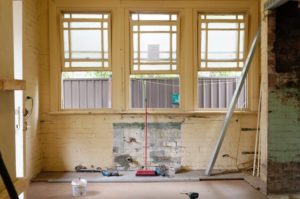Fixing to Buy a Fixer-Upper?
Before making the leap, learn the do’s & don’ts
By Meghan Diemel
If reality was every HGTV show we’ve seen, homebuyers would be able to find a fixer-upper in a great neighborhood for a bottom-dollar price and have $200,000 to spend in renovations that are miraculously completed in seven days.
Unfortunately, no matter how much we fancy ourselves a Chip or Joanna, that’s not real life. The average Joe doesn’t have access to an unlimited labor pool, paid placement or discounts for furnishings and appliances, and we certainly wouldn’t look as well-coiffed as the pair does when knocking down walls.
In other words, there are a few do’s and don’ts to consider before purchasing that fixer-upper.
 Do: Find the right house for the right place
Do: Find the right house for the right place
Tod Raehl, of Tod Raehl Remodeling in Neenah, says any prospective homebuyer needs to have a clear understanding of their financial parameters before buying any fixer-upper. “Do your homework first,” he recommends. “You know what the cost of the home is going to be. Before you make a commitment, try to get a ballpark figure of what it’s going to cost you to do the things you want to do, and then look at what the value will be when it’s complete. It doesn’t pay to put $100,000 into a house you bought for $100,000 when you’re in a $150,000 neighborhood and that’s what you’re going to get for the house [if you resell].”
That sentiment was echoed by Ben Fouts, owner, of LCF Homes and Design in Menasha.
“Something simple like [adding] a wall and door in a dining room to convert it to a bedroom — that might seem really simple, but it could, depending on the location of things, affect heating and cooling in the room, it might affect electrical code requirements, and then [it could affect] other obvious things like the finishes of the floor and plastering and painting,” he furthers.
Always try to consider how accessible the space is from above and below as well, Fouts says.
“If you’re remodeling a bathroom in a ranch home with an unfinished basement, that’s very simple to get at anything you need to,” he explains. “But say you’re doing a second-floor bathroom; now it’s going to get more complicated to get the wiring you need in there.”
Do: Take care of the essentials first
Before you tackle the actual remodeling for your fixer-upper, identify what you have planned for the future of the home. As master craftsman and owner Paul Driessen from Timber I nnovations explains, it’s common for longtime homeowners to allow improvements to fall behind. New owners may have to prioritize what’s necessary depending on how invested they want to be.
nnovations explains, it’s common for longtime homeowners to allow improvements to fall behind. New owners may have to prioritize what’s necessary depending on how invested they want to be.
“Are they keeping it just as a short-term or five-year home, or is this something they’re moving into and they anticipate spending a considerable amount of time in?” Driessen asks. “Those are the factors that determine what kind of investment they want to make in the house.”
After that’s decided, Raehl says fixer-upper owners should first address the roof, siding, windows and doors to ensure everything is sealed against weather and the elements.
“Make sure you do the things that have to be in good shape or intact in order to protect the structure of the house,” he says. “Then move onto the mechanicals: the furnace, the water heater, the air conditioner.”
In other words, “Don’t do a beautiful kitchen remodel with a questionable roof that leaks,” Raehl says.
Do: Decide a budget — and be upfront about it
 As Fouts states, the homeowner needs to establish a budget and be clear about it with the contractor. Though homeowners often keep that information to themselves, Fouts says it helps the contractor better guide the homeowner through the project and the choices they have available in regard to finishes.
As Fouts states, the homeowner needs to establish a budget and be clear about it with the contractor. Though homeowners often keep that information to themselves, Fouts says it helps the contractor better guide the homeowner through the project and the choices they have available in regard to finishes.
“They may want to do a tile shower stall in the master bathroom and say they’re looking to spend $3,000; I can tell them it’s not going to be able to happen for $3,000,” he said. “But, we can look at an acrylic surround instead. So, it’s helpful for that reason to have a budget established.”
Raehl and Driessen say it’s also important to
remember that you never know what’s behind a wall and to plan appropriately. Whether it’s hidden water damage, related mold problems, wiring not up to code or hodgepodge plumbing, there can be a mess waiting for the contractor.
“Give yourself a cushion,” Raehl furthers. “In remodeling, you expect the unexpected.”
Don’t: Think you can do it all yourself
The stars of home improvement shows make it look so easy; even when faced with dire conditions, it all seems to come together perfectly in the end. Driessen says that while there are certainly projects that the homeowner can do, there are others that need a professional touch. The key is to be realistic about your expertise in relation to your budget parameters and timeframe for the project.
And as Fouts explains, though there is always a professional who could take over a DIY project gone awry, it probably won’t happen in the timeframe you need it to.
“I’ve had some calls for people who start a remodel themselves and get in over their head,” he cautions. “It can tend to be a little bit harder to find a contractor who wants to come in and pick up where they left off. In today’s building climate, we all tend to stay booked out a couple weeks, if not a couple months, ahead.”
Driessen adds, “You can do all this work and spend all this money, and if you have a haphazard remodel, you didn’t gain anything.”










Leave a Comment